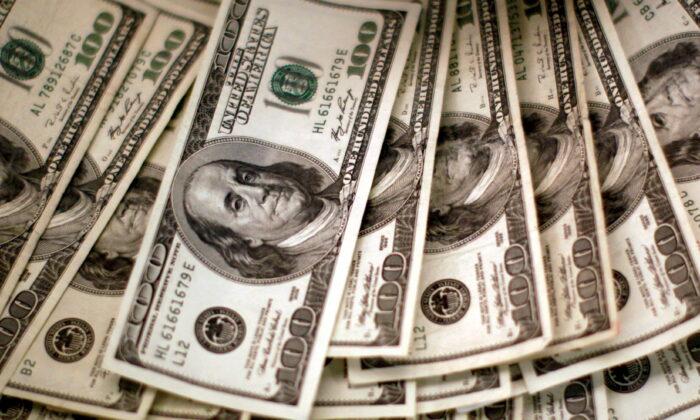LONDON—The dollar edged higher on Friday but was still set to end 2023 with a loss, reversing two straight years of gains, dragged down by market expectations that the U.S. Federal Reserve could begin easing interest rates as early as March.
The greenback crept higher on the last trading day of the year although currency moves were mostly subdued amid a holiday lull leading up to the New Year.
Since the Fed launched its aggressive rate-hike cycle in early 2022, expectations of how far U.S. rates would have to rise have been a huge driver of the dollar.
But as economic data subsequently pointed to signs that inflation in the United States is cooling, investors turned their focus to how soon the Fed could begin cutting rates—expectations that gathered steam after a dovish tilt at the central bank’s December policy meeting.
Against a basket of currencies, the greenback was up 0.12 percent on Friday to 101.35, rising from a five-month trough of 100.61 hit in the previous session.
The dollar index was still on track to lose more than 2 percent for the month and for the year.
“Markets are looking for a cut earlier in the U.S. and are less certain that the European Central Bank (ECB) will cut as quickly, so that’s why the dollar is very soft,” said Niels Christensen, chief analyst at Nordea.
“We also have positive risk appetite which is another negative for the dollar. Going into 2024, the soft dollar will be a theme towards the March central bank meetings.”
A weakening dollar, meanwhile, brought relief to other currencies, with the euro last at $1.1049, hovering just below a five-month peak of $1.11395 reached on Thursday and on track to rise more than 3 percent for the year, its first positive year since 2020.
Sterling was on track for a 5 percent yearly gain, its best performance since 2017. The British pound was last 0.2 percent lower on the day at $1.2711.
While policymakers at the ECB and the Bank of England (BoE) did not signal any imminent rate cuts at their policy meetings this month, traders continue to bet that a Fed pivot and the prospect of lower U.S. rates next year would give room for other major central banks to follow suit.
“While it feels like the market might have moved too far too fast, the facts are that growth is non-existent in Europe, slowing in the U.S., and inflation is falling globally,” said CJ Cowan, portfolio manager at Quilter Investors.
“The ECB is famously slow to change policy course so almost two cuts priced by April looks aggressive, even if it might be the right thing to do.”
Elsewhere in Europe, the Norwegian crown strengthened against both the euro and the dollar on Friday after the Norwegian central bank said it would sharply reduce its purchase of foreign exchange for the sovereign wealth fund in January, cutting it to 350 million Norwegian crowns ($34.41 million) per day from 1.4 billion previously.
“It was a surprise that they announced such a low number,” Nordea’s Christensen said.
Asia Contrast
The yen is set to fall more than 7 percent in 2023, extending its losses into a third straight year, as the Japanese currency continues to come under pressure from the Bank of Japan’s (BOJ) ultra-loose monetary policy stance.While market expectations are for the BOJ to exit negative interest rates in 2024, the central bank continues to stand by its dovish line and has provided little clues on if, and how, such a scenario could play out.
“The outlook for Japan is encouraging going into 2024, with expectations of robust economic growth and improving inflation that shows signs of being sustainable,” said Aadish Kumar, international economist at T. Rowe Price, citing a weak currency and accommodative policy stance as “key supports” to the view.
“Any potential moves to tighten policy via a hike in interest rates represent a key risk to the outlook. Given the BOJ will not want to risk undoing all the good work achieved to date, we believe it will remain dovish in its communication and keep policy accommodative.”
The yen was last 0.3 percent weaker at 141.835 per dollar.
In China, the onshore yuan was headed for a yearly loss of nearly 3 percent, pressured by a faltering post-COVID-19 recovery in the world’s second-largest economy.
The yuan last stood at 7.111 per dollar, while its offshore counterpart was last at 7.1286 per dollar.
($1 = 10.1702 Norwegian crowns)







